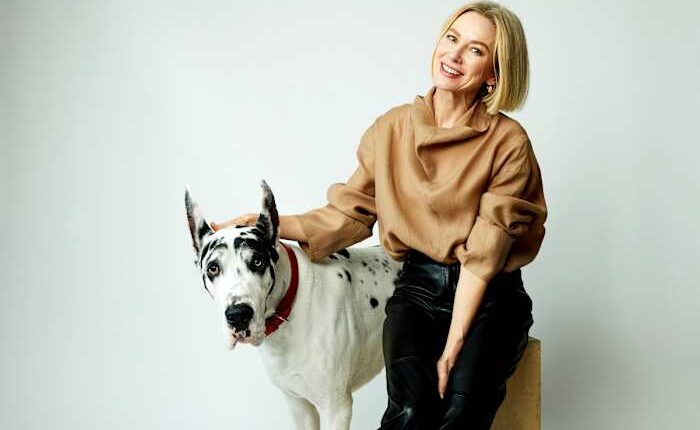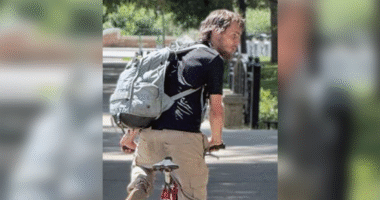
NEW YORK – The lead actor in “The Friend” has the easygoing walk of Robert Mitchum and the sad, droopy eyes of Peter Lorre. His facial features are iconic Hollywood qualities—immediately familiar yet forever mysterious. Walking alongside his co-stars, Naomi Watts and Bill Murray, draws attention from onlookers.
“People would go, ‘Hey, get a load of the blonde,‘” Murray says before acting out a double take. “Get a load of THE DOG!’”
Bing, the unique Great Dane in “The Friend,” continues the tradition of popular four-legged stars on the big screen. However, unlike his predecessors, Bing is exceptionally large. Toto could fit in his paw, and Asta could comfortably perch on his head. David Siegel, the co-director of “The Friend,” approximates Bing outweighs Watts by a significant 40 pounds (18 kilograms). Despite his gentle nature, Bing resembles more of a massive creature from “Star Wars” than the usual dog movie star.
“The Friend,” set to debut in theaters nationwide on Friday, breaks the mold of traditional dog-centric films. Based on Sigrid Nunez’s award-winning novel from 2018, the film features Watts as Iris, a writer in New York who inherits Apollo (played by Bing) after the passing of her mentor, Walter (played by Murray). Their cramped living situation faces challenges not only from Iris’ building rules regarding pets but also from Apollo’s personal mourning process.
“How creatures find each other — what we share with other humans but also animals — that’s where the solace comes from,” says Siegel. “We cast Bing to some degree for his countenance, just like we cast actors for their countenance. Does he have a face that can look sad? Does he look happy when he’s happy?”
On a recent spring day, Bing did indeed look happy, if a little worn out. He had spent the day at photo shoots and other media appearances, with his owner, Beverly Klingensmith, shuttling him around Manhattan in a van. Bing’s duties, which included appearances on “The Tonight Show” and “The View,” were arguably more demanding of him than his biped co-stars. In between interviews, he warmly nuzzled a reporter while a grateful publicist compared him, given the pressures of a movie marketing, to an emotional support animal.
“At one of the Q&As, every time he’d move, the audience would go, ‘Awww,’” said Klingensmith. “Bill was like: ‘I told them not to bring out the dog yet.’”
But Murray and Watts have grown accustomed to being upstaged by their co-star. Not only that, as proud “dog people,” they’re delighted by Bing and praise him as not just a good boy but a fine actor. Murray has long maintained he wouldn’t trust anyone that a dog didn’t like.
“Dogs have a pretty good sense of who’s OK,” Murray muses. “I’ve met many thousands of people and there’s a real high number of people I wouldn’t trust. But as far as dogs, there’s maybe only been, like, three.”
For writer-directors Scott McGehee and Siegel, the filmmaking duo of “The Deep End” and “What Maisie Knew,” the prominence of the dog in Nunez’s book — a black-and-white Great Dane graces the cover — was both a great hook for the movie and the biggest challenge in making it. When they contacted trainer Bill Berloni, he urged them to consider another breed.
“When you put that dog on the cover of a book that wins the National Book Award, it’s got to be that dog,” says Siegel, laughing. “Bill was like, ‘Can’t it be another dog?’ We were like (holding up imaginary book): ‘Look.’”
An extensive search ultimately led them to an obedience-training club in Des Moines, Iowa. There, they found Bing and Klingensmith, who runs a kennel on a 10-acre property in Newton, Iowa, with her husband. The directors, having already looked coast-to-coast, stopped their search immediately.
“We kind of knew right away,” McGehee says. “He was a little too young at the time. We thought we were going to be making the movie that spring. Then the pandemic hit. So he aged beautifully right into the role.”
“If you see George Clooney in person, it’s like he attracts light in a special way,” adds McGehee. “Bing has that.”
As much as Berloni tried to prep Klingensmith on what lay ahead, she acknowledges, while in the midst of a hectic publicity tour, that she didn’t fully realize what she was getting into. But Bing responded well to the filmmaking process. (A representative of the American Humane Society was also present on set.)
“He loves to do things. The days where he had really active behaviors were his favorites,” says Klingensmith. “And what dog doesn’t want to spend 24/7 with their owner?”
Special care was taken to acquaint Bing and Watts — not just to bring them closer but so that Watts would feel comfortable keeping such a powerful animal safe on the streets of New York. A huge amount of “The Friend” unfolds with just the two of them interacting — a testament to both Watts’ subtle, quicksilver powers and to Bing’s expressiveness.
“He was a very curious dog and he did really look at you with attention. I found him a pure delight to work with,” Watts says. “The scene when I break down, if he hears crying, he’s a little spooked. He picks up on everything. He’s like: ‘Is something wrong?’”
Can a dog act? It’s a question that might not have bedeviled philosophers or animal-rights activists, but that anyone watching a movie like “The Friend” is sure to ponder. Murray, who voiced one in Wes Anderson’s “Isle of Dogs,” is an ardent believer.
“The dog gives an amazing performance,” Murray says. “When I first saw some of the cut footage, I realized the dog had been listening to everything that’s going on in every scene. The dog’s reactions to what’s happening in the scene is better than many actors or actresses I’ve worked with. Many. Not Naomi.”
Anytime a dog is pushed to the center of a movie, one inevitably worries for their fate. (There’s even a website, www.DoestheDogDie.com, committed to warning moviegoers.) As a critic long traumatized by films like “Old Yeller” and “Umberto D.,” the Will Smith movie “I Am Legend” even once prompted me to write an open letter to Hollywood, pleading it to spare the puppy dogs.
“The Friend” plays with that tradition, bookending the movie with reflections on dog movies and an early assurance that — unlike in the book — the dog makes it this time. “Very early on, we were like: We cannot kill the dog,” McGehee says.
For a movie that’s not so much about locating a solution to grief as it is about finding comfort on your way through it, it’s one concession — a bone — to those who have suffered enough.
“People have lost dogs and felt like this. People have lost people and felt like this, and their only solace has been a dog. Or their only solace has been a person,” Murray reflects. “The movie really bangs on both sides of the animal kingdom.”
Copyright 2025 The Associated Press. All rights reserved. This material may not be published, broadcast, rewritten or redistributed without permission.

















